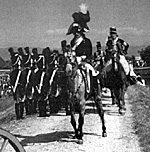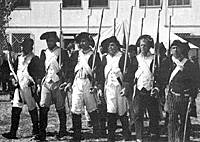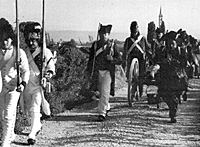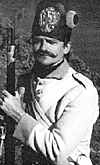The latest bicentennial to be celebrated took place in September 1996, at Arcole in Northern Italy. And what a international gathering it proved to be, the armies of Austria and France being formed by re-enactors from England, Germany, France, Austria, Italy, the Czech Republic and Slovakia. The journey to Italy was daunting. Through the Channel Tunnel, across Northern France to the Swiss border at Basle. Down through the breathtakingly beautiful and dramatic countryside of Switzerland, where you can dabble your toes in alpine streams at motorway rest areas! On through the endless cavernous stretches of the St. Gotthard tunnel which carries you through the Alps until the Italian border was reached and crossed at Como.
Our first base was at the small town of Lenato, close to the south-western corner of Lake Garda. Here, after 31 hours of buttock-numbing driving, we made camp within the walls of the beautiful medieval castle which dominates the town. Re-enactors from Germany and Austria who werealready in residence made their weary new arrivals most welcome depite the very late hour. The copious quantities of local wine on offer were also much appreciated. And so to sleep. Lenato is a sleepy but friendly town. The day was spent exploring the castle, drilling, and making up rounds for the coming battle. The bars dotted around the town square were decorated with small clusters of uniformed re-enactors, raising scarcely a glance from the local residents. It was almost as thought it was perfectly normal for a Napoleonic army to pass through the town. However, the resident s of Arcole would more than make up fior this lack of attention! In the evening, a somewhat bizarre skirmish was fought through the town square and back up through the winding streets to the castle, all taking place rather too quickly for my liking.
Lenato had been great, but it was time to move on to Arcole and prepare for bigger and better events. Arcole is another tiny town. It boasts three bars (one with a pizzeria), a post office, bakers, and agricultural supplies shop, electrical goods shop and a derelict cinema. Unfortunately it also contains a large church with a belfry, in shape strangely reminiscent of an American lunar rocket. I say unfortunately because belfries contain bells, and in Catholic countries bells ring quite a lot. You tend to notice this when you are camped directly below them. I think the 6.30 in the morning chimes were my personal favourite!
We had some spare time on our first day at Arcole so while some took advantage of this and enjoyed a trip to Venice, other explored the battlefield. The whole area at the time of the battle was marshy and it was only possible for the soldiers to move across it along dykes and causeways. These raised pathways are still there overlooking the sunken fields, and so it is possible to follow the exact pathway between Ronco and Arcloe that the soldiers took two hundred years before. I walked from the site of the famous bridge of Arcole along the causeway to Ronco, where the French launched a bridge of boats across the Adige, and back again. It took about three and half hours but I enjoyed every minute. For the French soldiers attacking the bridge at Arcole, along a causeway swept by musketry and canister it would not have been such a pleasant experience.
It is said that a picture is worth a thousand words. If you look at any of the artistic renderings of the Battle of Arcole you will be confronted by images of Napoleon cutting a heroic figure, clutching a French standard and leading his men over the bridge. To the casual observer he is presumably about to scatter his hapless Austrian opponents to the four winds. Napoleon had a great PR man! The truth is somewhat different. The same picture a few minutes later would not have done so much to enhance his image. Napoleon did take up a standard to encourage Augereau's men to attack the bridge; they had already been driven back by Austrian firepower and were not keen to repeat the experience. Before Napoleon's presence could affect the situation a fierce Austrian counterattack swept over the bridge driving the French before it. Napoleon, caught up in the maelstrom, found himslef floundering in the marsh below the causeway and had to be extricated by his desperate staff, narrowly avoiding capture or death. It is interesting to ponder that the heroic images of Napoleon at Arcole could therefore just as easily have been drawn to illustrate the death of just another genral of the Revolutionary Wars. In fact, these familiar images show only the first act of the battle, For three days, the two sides threw themselves viciously at each other along the causways until eventually, on the third day, finding themselves in danger of being outflanked and overun, the Austrians retired in good order.
The day of battle dawned early. At 6.30 a.m., as it was a Sunday, we had the special exended play version of the church bells! It was not an inviting start to the day. The air was icy, and a low mist had ensured that everything outside of the tents was damp and cold. Mugs of coffee or tea and a croissant, consumed whilst huddled around the camp fire, made you think more of 1812 rather than 1796, but we had the consolation of knowing that when the sun burnt through the mist we would be rewarded with another glorious day.
We were to be split into two forces for the battle: half of the Austrian force and virtually the whole of the French were to be bussed to Ronco at 8.00 a.m. to begin the action. In 1796 the French had built a bridge of boats across the Adige at Ronco prior to the start of the battle. There is still no bridge to this day, so having been driven as close to the start point as possible, we abandoned our vehicles and began to march. From Ronco of Arcole, following the causeway as the troops did in 1796, is about three miles. For us it was the start of a two hour running skirmish. From Ronco, the Austrian line and light troops began retiring on Arcole, pursued by the French. The Austrians made a number of stands before the overwhelming number of French who forced them to retire by using their fast moving light cavalry to great effect. For me, serving as an Austrian infantryman, this was one of the most rewarding aspects of the whole weekend: here, on the narrowest of all battlefields, we were walking and 'fighting' directly in the footsteps for those who had gone before. One minute we were skirmishing with French light troops about 100 metres away, the next moment scrambling as fast as possible back up the causeway in an attempt to avoid the French cavalry which had suddenly appeared from nowhere.
The French advance was inexorable, the sun was getting higher and the retreat was taking its effect. Breathless, the Austrian troops turned a bend in the causeway then, leaving a thin skirmish line to hold the rear, the rest continued their retreat, hoping to gain time for a rest. The skirmish line, now alone, awaited the main French force to sweep round the bend and press fiercely. A minute or two passed, then a few more. No sign of the French. This was no errain for a devious outflanking manoeuvre, so where were they? Cautiously the skirmihsers edged forward, and there around the bend was the French Army, lounging on the grass appearing to all the world as though they were on a summer afternoon's picnic. And I thought it was only the British that stopped everything for tea!
At the time of the battle the bridge had been a wooden construction, but this has long since been replaced by a brick and concrete structure. The Alpone, which runs gently under its narrow span, still flows between steep river banks. It is a peaceful spot, where we had seen otters playing on the banks the day before. But now this two hundred year old peace was about to be broken. Preparations for the defence of the bridge had been continuing all morning. The bridge itself was barricaded and lining the far bank was a battery of four guns and three large Austrian infanty formations.
As soon as we had safely taken our positions behind the barricade the artillery opened fire, to gasps from the assembled crowd. The relentless French pursuit immediately ground to a halt. Receiving heavy fire from front and flank, the French command seemed to dither for a while then, in a effort to relieve the mounting pressure, they launched a full scale attack on the bridge.
The charge was met with concentrated artillery fire and musketry and was doomed to fail. A second great attack rolled forward only to be beated back again. This time the defenders of the barricade sallied forward but, quickly losing their formation, they were easily driven back. Once more the French came forward and this time the ferocity of the attack forced the defenders back across the bridge. This, however, just exposed the attackers to even more close range fire from the main Austrian force on the far bank. The fire forced the French back to the causeway once more and enabled the Austrians to reoccupy the bridge. There was now a brief lull in the battle while everyone got their breath back and supplies of water were handed around, to the relief of the parched troops.
The truce was brief: without warning French cavalry smashed their way onto the bridgeand into the surprised infantry. The horsemen were repulsed, but almost immediately the French infantry began to attack once more, some managing to wade across the Alpone beneath the bridge. The attack on the bridge itself was again thrown back but casualties were mounting and it was doubtful whether the defenders could stand against another onslaught. And so it proved: gathering his forces for one last thrust, the French commander raised a standard anove his head an unleashed his men. The Austrian defenders were no longer able to oppose the determination of the French and fell back on the town where a last attempt was made to stem the French pursuit. This too failed, and Arcole fell to the victorious French for the second time in two hundred years.
And so ended our great Italian adventure, other than the small matter of the 31 hour return journey! Many happy memories remain. The spirit of co-operation amongst re-enactors right across Europe, and the enthusiasm of our Italian hosts was refreshing. The sight of revolutionary uniforms dominating the battlefield was thrilling as was the battlefield itself. The camaraderie of the trip, the great friends made, and of course the relaxed Italian lifestyle, the beer, the wine, the food, the sun......perfect. But there was one downside: the Human Zoo.
Now, as a re-enactor you get used to people looking at you. Fair enough, I guess there is a bit of an exhibitionist in all of us, but the population of Arcole was something else. From the first thing in the morning, to the last thing at night, there was an endless parade through our campsite. Mums, dads, grannies, kids, bikes, mopeds, you name it, they came. Nothing wrong in that I hear you say, which is true. But they didn't just pass through. They stopped, stood in front of you and stared. They stared continually for minutes at a time, never saying a word. They stared at you when in uniform, they stared at you in civvies. They stared at you when put up your tent, and they stared at you when you took it down again. They stared when you had your breakfast, or when you were chatting to your friends. They stred when you came back from the shower, they even stared at a pair of underpants hanging up. Thye walked in to your tent while you were grabbing a few minutes rest and stared. And then they took photos, photos of absolutely anything. In uniform or civvies, it didn't matter: people standing or sitting, talking or sleeping, drinking or eating, cleaning equipment or not cleaning equipment, it was all recorded on film forever!
So, the morale of this tale is, if you ever meet an Italian and he or she offers to show you their photos of Arcole.....RUN!
And so the Battle of Arcole once more returns to the pages of history. The 200th Anniversary was truly memorable for me and I can't wait for our return to Italy this year when it will be the turn of the Battle of Rivoli to shake off the dust of two centuries and emerge spectacularly into the spotlight.
 It's a good time to be a Napoleonic re-enactor. Have musket, will travel, is likely to be the motto for the next nineteen years as bicentennials, from Rivoli to Waterloo, take their place in the calendar. How many will actually be planned and efought is unknown at this stage but the years ahead should prove both fascinating and exciting, particularly if you're not a redcoat!
It's a good time to be a Napoleonic re-enactor. Have musket, will travel, is likely to be the motto for the next nineteen years as bicentennials, from Rivoli to Waterloo, take their place in the calendar. How many will actually be planned and efought is unknown at this stage but the years ahead should prove both fascinating and exciting, particularly if you're not a redcoat! A spirited, but breathless, resistance by the Austrians was finally ended and the French tricolor raised above the battlements. After such exertions there was nothing else for it but to retire to a local pizzeria, and a bar or two, to commemorate our first battle in Italy, a country that should be applauded for its very liberal licensing hours. I think we finally found our way back to the castle at about three in the morning.
A spirited, but breathless, resistance by the Austrians was finally ended and the French tricolor raised above the battlements. After such exertions there was nothing else for it but to retire to a local pizzeria, and a bar or two, to commemorate our first battle in Italy, a country that should be applauded for its very liberal licensing hours. I think we finally found our way back to the castle at about three in the morning. Back in modern day Arcole, preparation began for a whole series of events which were to lead up to the main battle. As mentioned before, Arcole is not a large place, and could not afford to foot the bill for the event alone. The adjacent towns of Ronco, Belfiore, Veronella, San Bonifacio and Cologna Veneta, therefore, contributed to the proceedings and in return each had a small event in their town. The evening skirmish in Veronella was particularly interesting! Part of it involved Austrian troops occupying the Town Hall and firing from office windows, trying not to destroy the computer equipment in the process. However, after each of these skirmishes, table would miraculously appear laden with food and drink to sustain the battle-weary troops, as well as cauldrons of boiling water with which to clean our muskets. Such consideration would be unheard of at home.
Back in modern day Arcole, preparation began for a whole series of events which were to lead up to the main battle. As mentioned before, Arcole is not a large place, and could not afford to foot the bill for the event alone. The adjacent towns of Ronco, Belfiore, Veronella, San Bonifacio and Cologna Veneta, therefore, contributed to the proceedings and in return each had a small event in their town. The evening skirmish in Veronella was particularly interesting! Part of it involved Austrian troops occupying the Town Hall and firing from office windows, trying not to destroy the computer equipment in the process. However, after each of these skirmishes, table would miraculously appear laden with food and drink to sustain the battle-weary troops, as well as cauldrons of boiling water with which to clean our muskets. Such consideration would be unheard of at home. The phoney war soon ended and, as the French drums began to sound the assembly, so the action resumed. The French pursuit this ime was even more aggressive than before and there were a few anxious 'Austrian' faces as they stormed forward over a road that crossed the causeway to great cheers from a group of onlookers that had congregated at this point. However, the dominating bell tower of Arcole showed us that safety was close at hand and, pushing on, we reached the safety of the bridge over the Alpone stream on the outskirts of the town. This was to be the scene of the coming battle.
The phoney war soon ended and, as the French drums began to sound the assembly, so the action resumed. The French pursuit this ime was even more aggressive than before and there were a few anxious 'Austrian' faces as they stormed forward over a road that crossed the causeway to great cheers from a group of onlookers that had congregated at this point. However, the dominating bell tower of Arcole showed us that safety was close at hand and, pushing on, we reached the safety of the bridge over the Alpone stream on the outskirts of the town. This was to be the scene of the coming battle.
Back to Age of Napoleon No. 24 Table of Contents
Back to Age of Napoleon List of Issues
Back to MagWeb Master List of Magazines
© Copyright 1998 by Partizan Press.
This article appears in MagWeb (Magazine Web) on the Internet World Wide Web.
Other military history articles and gaming articles are available at http://www.magweb.com